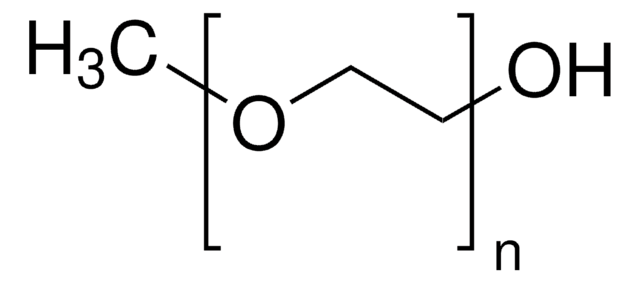373001
Poly(ethylene glycol)
average Mn 4,600, hydroxyl
Synonym(s):
Polyethylene glycol, PEG
Sign Into View Organizational & Contract Pricing
All Photos(4)
About This Item
Linear Formula:
H(OCH2CH2)nOH
CAS Number:
MDL number:
UNSPSC Code:
12352104
PubChem Substance ID:
NACRES:
NA.23
Recommended Products
product name
Poly(ethylene glycol), average Mn 4,600
form
flakes
Quality Level
mol wt
average Mn 4,400-4,800
average Mn 4,600
viscosity
180 cSt(210 °F)
mp
57-61 °C (lit.)
Ω-end
hydroxyl
α-end
hydroxyl
SMILES string
C(CO)O
InChI
1S/C2H6O2/c3-1-2-4/h3-4H,1-2H2
InChI key
LYCAIKOWRPUZTN-UHFFFAOYSA-N
Looking for similar products? Visit Product Comparison Guide
Related Categories
General description
Poly(ethylene glycol) (PEG) is a biocompatible water soluble poly(ether) with low toxicity. It is majorly used as a biopolymer for the surface modification of biomaterials. Its properties include hydrophilicity and non-immunogenicity.
Application
PEG can be used in the formation of polymeric hydrogels for the formation of biomedical applications.
Storage Class Code
11 - Combustible Solids
WGK
WGK 1
Flash Point(F)
Not applicable
Flash Point(C)
Not applicable
Personal Protective Equipment
dust mask type N95 (US), Eyeshields, Gloves
Choose from one of the most recent versions:
Already Own This Product?
Find documentation for the products that you have recently purchased in the Document Library.
Customers Also Viewed
Nano-magnetic particles used in biomedicine: Core and coating materials
Karimi Z, et al.
Materials Science and Engineering Technology, 33(5), 2465-2475 (2013)
Bacterial adhesion is affected by the thickness and stiffness of poly (ethylene glycol) hydrogels
Kolewe KW, et al.
ACS Applied Materials & Interfaces, 10(3), 2275-2281 (2018)
Biomedical hydrogels
Burdick JA, et al.
Biomaterials, Artificial Organs and Tissue Engineering, 33(5), 107-115 (2005)
Morphology of Photopolymerized End-linked Poly(ethylene glycol) Hydrogels by Small Angle X-ray Scattering
Waters DJ, et al.
Macromolecules, 43(16), 6861-6861 (2010)
Idalis Villanueva et al.
Acta biomaterialia, 5(8), 2832-2846 (2009-06-11)
The pericellular matrix (PCM) surrounding chondrocytes is thought to play an important role in transmitting biochemical and biomechanical signals to the cells, which regulates many cellular functions including tissue homeostasis. To better understand chondrocytes interactions with their PCM, three-dimensional poly(ethylene
Our team of scientists has experience in all areas of research including Life Science, Material Science, Chemical Synthesis, Chromatography, Analytical and many others.
Contact Technical Service


